
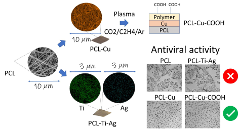
Biodegradable Nanohybrid Materials as Candidates for Self-Sanitizing Filters Aimed at Protection from SARS-CoV-2 in Public Areas
Anton Manakhov, Elizaveta S. Permyakova, Natalya A. Sitnikova, Alphiya R. Tsygankova, Alexander Yu Alekseev, Maria V. Solomatina, Victor S. Baidyshev, Zakhar I. Popov, Lucie Blahová, Marek Eliáš, Lenka Zajíčková, Andrey M. Kovalskii, Alexander N. Sheveyko, Philipp V. Kiryukhantsev-Korneev, Dmitry V. Shtansky, David Nečas, Anastasiya O. Solovieva
Molecules 27 (2022) 1333
DOI: 10.3390/molecules27041333
The COVID-19 pandemic has raised the problem of efficient, low-cost materials enabling the effective protection of people from viruses transmitted through the air or via surfaces. Nanofibers can be a great candidate for efficient air filtration due to their structure, although they cannot protect from viruses. In this work, we prepared a wide range of nanofibrous biodegradable samples containing Ag (up to 0.6 at.%) and Cu (up to 20.4 at.%) exhibiting various wettability. By adjusting the magnetron current (0.3 A) and implanter voltage (5 kV), the deposition of TiO2 and Ag+ implantation into PCL/PEO nanofibers was optimized in order to achieve implantation of Ag+ without damaging the nanofibrous structure of the PCL/PEO. The optimal conditions to implant silver were achieved for the PCL-Ti0.3-Ag-5kV sample. The coating of PCL nanofibers by a Cu layer was successfully realized by magnetron sputtering. The antiviral activity evaluated by widely used methodology involving the cultivation of VeroE6 cells was the highest for PCL-Cu and PCL-COOH, where the VeroE6 viability was 73.1 and 68.1%, respectively, which is significantly higher compared to SARS-CoV-2 samples without self-sanitizing (42.8%). Interestingly, the samples with implanted silver and TiO2 exhibited no antiviral effect. This difference between Cu and Ag containing nanofibers might be related to the different concentrations of ions released from the samples: 80 μg/L/day for Cu2+ versus 15 µg/L/day for Ag+. The high antiviral activity of PCL-Cu opens up an exciting opportunity to prepare low-cost self-sanitizing surfaces for anti-SARS-CoV-2 protection and can be essential for air filtration application and facemasks. The rough cost estimation for the production of a biodegradable nanohybrid PCL-Cu facemask revealed ~$0.28/piece, and the business case for the production of these facemasks would be highly positive, with an Internal Rate of Return of 34%.
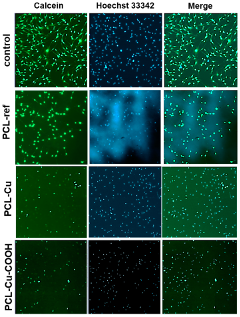
Electrospun Biodegradable Nanofibers Coated Homogenously by Cu Magnetron Sputtering Exhibit Fast Ion Release. Computational and Experimental Study
Anton Manakhov, Natalya A. Sitnikova, Alphiya R. Tsygankova, Alexander Yu. Alekseev, Lyubov S. Adamenko, Elizaveta Permyakova, Victor S. Baidyshev, Zakhar I. Popov, Lucie Blahová, Marek Eliáš, Lenka Zajíčková, Anastasiya O. Solovieva
Membranes 11 (2021) 965
DOI: 10.3390/membranes11120965
Copper-coated nanofibrous materials are desirable for catalysis, electrochemistry, sensing, and biomedical use. The preparation of copper or copper-coated nanofibers can be pretty challenging, requiring many chemical steps that we eliminated in our robust approach, where for the first time, Cu was deposited by magnetron sputtering onto temperature-sensitive polymer nanofibers. For the first time, the large-scale modeling of PCL films irradiation by molecular dynamics simulation was performed and allowed to predict the ions penetration depth and tune the deposition conditions. The Cu-coated polycaprolactone (PCL) nanofibers were thoroughly characterized and tested as antibacterial agents for various Gram-positive and Gram-negative bacteria. Fast release of Cu2+ ions (concentration up to 3.4 μg/mL) led to significant suppression of E. coli and S. aureus colonies but was insufficient against S. typhimurium and Ps. aeruginosa. The effect of Cu layer oxidation upon contact with liquid media was investigated by X-ray photoelectron spectroscopy revealing that, after two hours, 55% of Cu atoms are in form of CuO or Cu(OH)2. The Cu-coated nanofibers will be great candidates for wound dressings thanks to an interesting synergistic effect: on the one hand, the rapid release of copper ions kills bacteria, while on the other hand, it stimulates the regeneration with the activation of immune cells. Indeed, copper ions are necessary for the bacteriostatic action of cells of the immune system. The reactive CO2/C2H4 plasma polymers deposited onto PCL-Cu nanofibers can be applied to grafting of viable proteins, peptides, or drugs, and it further explores the versatility of developed nanofibers for biomedical applications use.
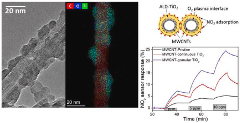
Manipulating MWCNT/TiO2 heterostructure morphology at nanoscale and its implications to NO2 sensing properties
Preeti Kaushik, Marek Eliáš, Jan Prášek, Jan Michalička, Lenka Zajíčková
Materials Chemistry and Physics 271 (2021) 124901
DOI: 10.1016/j.matchemphys.2021.124901
Multi-walled carbon nanotubes (MWCNTs) based heterostructures were prepared by oxygen plasma treatment and atomic layer deposition (ALD) of TiO2 carried on MWCNTs. Different TiO2 structures (island, granular and continuous forms) on the nanotubes were obtained by varying the processing parameters. Chemical inertness of MWCNTs led to the ALD of TiO2 in an island form. Oxygen plasma treatment ensured deposition of a continuous TiO2 film, 5 nm in thickness. A granular form of TiO2 was obtained on oxygen plasma treated MWCNTs using shorter duration of Ti-precursor pulse. Different imaging modes in high resolution transmission electron mi croscopy visualized TiO2 nanostructures and defects in MWCNT walls. The latter were also confirmed by Raman spectroscopy. The morphology of TiO2 and oxygen plasma treatment of the MWCNTs highly affected the NO2 sensing behavior of chemiresistive heterostructure sensors at room and elevated temperatures. All investigated sensors exhibited a decrease in the resistance upon exposure to NO2 gas which implies a p-type sensor response. The granular TiO2/MWCNTs heterostructure showed the highest response towards NO2 gas as compared to the island and continuous forms.
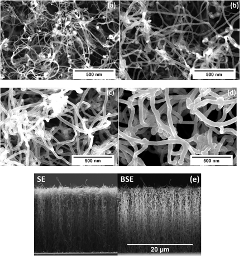
Atomic Layer Deposition of Titanium Dioxide on Multi-Walled Carbon Nanotubes for Ammonia Gas Sensing
Preeti Kaushik, Marek Eliáš, Jan Michalička, Dirk Hegemann, Zdeněk Pytlíček, David Nečas, Lenka Zajíčková
Surface and Coatings Technology 370 (2019) 235-243
DOI: 10.1016/j.surfcoat.2019.04.031
Carbon nanotube (CNTs)-metal oxide semiconductor (MOS) hybrid nanostructures can provide a new pathway for room temperature chemiresistive gas sensors due to combined properties of both the materials and the creation of heterojunctions between CNTs and MOS. Multi-walled carbon nanotubes (MWCNTs) were grown on Si substrates coated with SiO2 layer by catalytic chemical vapor deposition (CCVD) and coated by TiO2 films of different nominal thicknesses, 5, 10 and 20 nm, using atomic layer deposition (ALD). ALD is a self-limiting surface process providing highly uniform and conformal coatings if reactive sites exist on the surface. The CNT surface is quite inert and therefore, a modification of MWCNTs by carboxyl plasma polymer (PP) film was applied prior to ALD of TiO2. The carboxyl PPs improved film uniformity, even though the thinnest TiO2 film still formed an island-like structure. Raman spectroscopy revealed that coating by TiO2 or carboxyl PP increased structural disorder of sp2 carbon in the MWCNTs and the thinnest TiO2 coatings induced the lowest disorder. The thinnest coatings also resulted in the highest sensor response to NH3. Nevertheless, for all thicknesses the sensors coated with carboxyl PP/TiO2 doublelayer showed higher response as compared to the pristine CNTs and those without the carboxyl PP film.
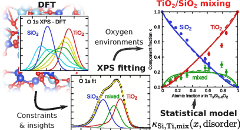
Unravelling local environments in mixed TiO2–SiO2 thin films by XPS and ab initio calculations
Pavel Ondračka, David Nečas, Michele Carette, Stéphane Elisabeth, David Holec, Agnés Granier, Antoine Goullet, Lenka Zajíčková, Mireille Richard-Plouet
Applied Surface Science 510 (2020) 145056
DOI: 10.1016/j.apsusc.2019.145056
Mixed Ti(x)Si(1−x)O₂ oxide can exhibit a partial phase separation of the TiO₂ and SiO₂ phases at the atomic level. The quantification of TiO₂–SiO₂ mixing in the amorphous material is complicated and was so far done mostly by infrared spectroscopy. We developed a new approach to the fitting of X-ray photoelectron spectroscopy data for the quantification of partial phase separation in amorphous Ti(x)Si(1−x)O₂ thin films deposited by plasma enhanced chemical vapour deposition. Several fitting constraints reducing the total number of degrees of freedom in the fits and thus the fit uncertainty were obtained by using core electron binding energies predicted by density functional theory calculations on Ti(x)Si(1−x)O₂ amorphous supercells. Consequently, a decomposition of the O 1s peak into TiO₂, SiO₂ and mixed components was possible. The component areas ratios were compared with the ratios predicted by older theoretical models based on the atomic environment statistics and we also developed several new models corresponding to more realistic atomic structure and partial mixing. Based on the comparison we conclude that the studied films are mostly disordered, with only a moderate phase separation.